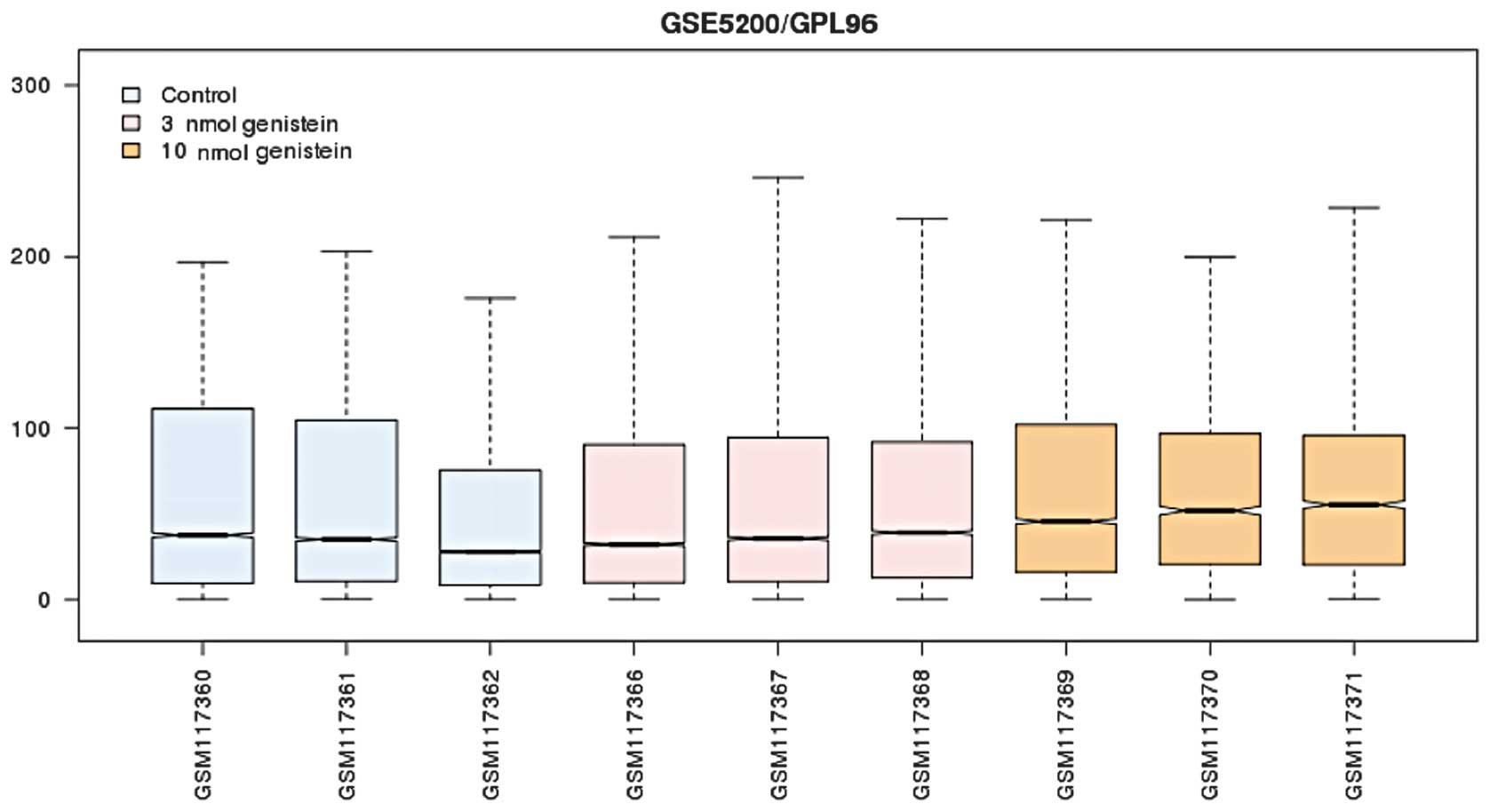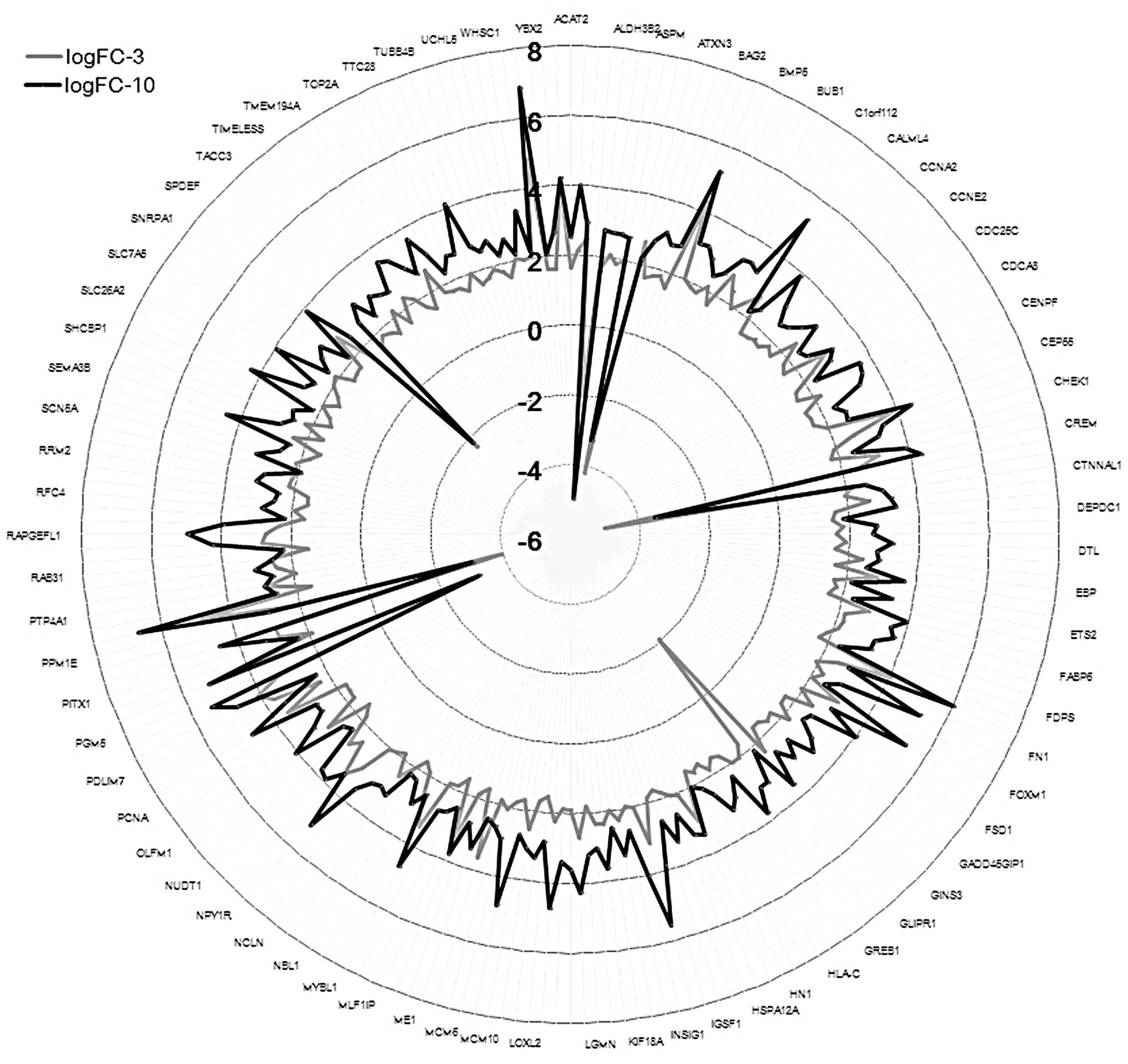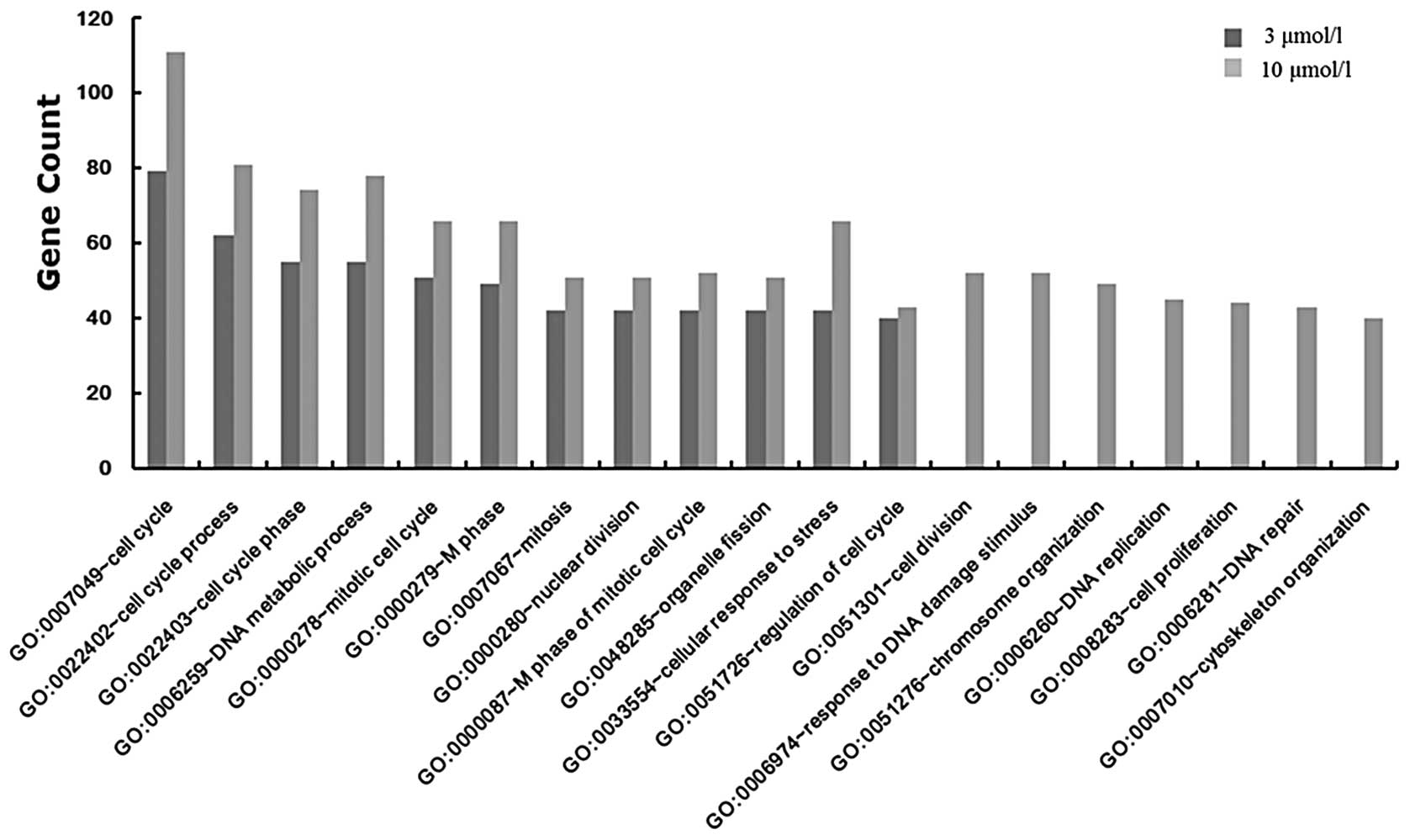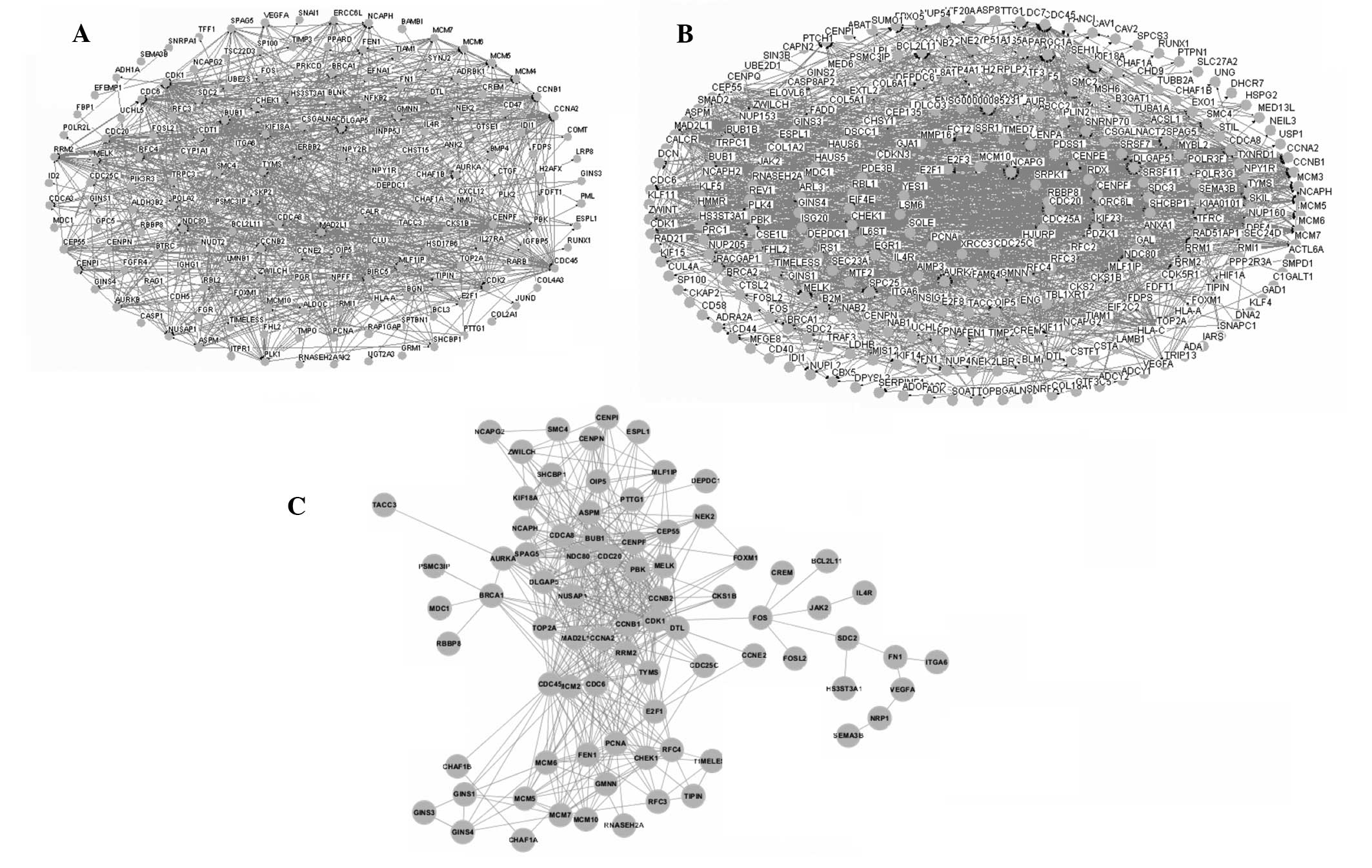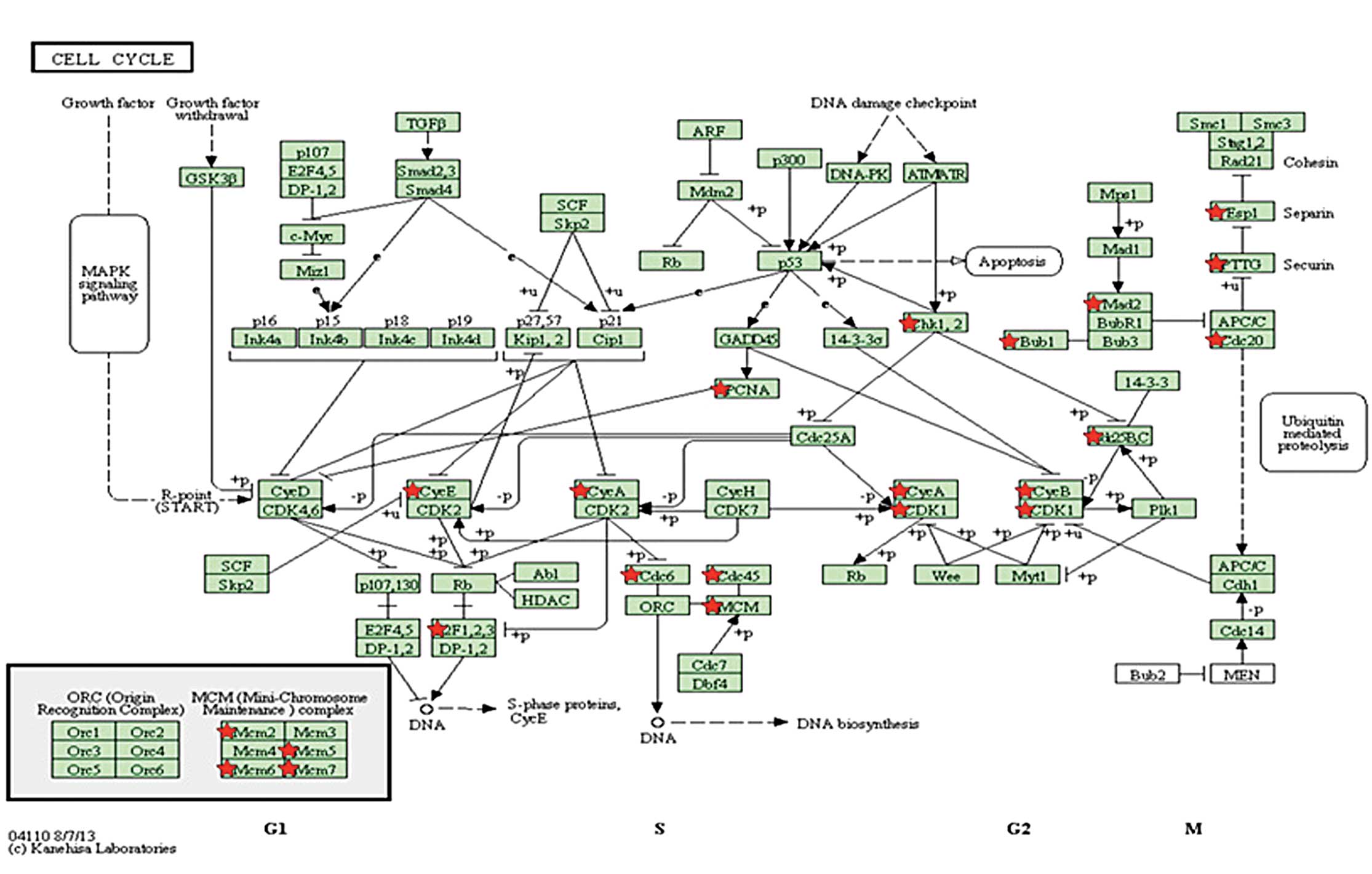Potential therapeutic mechanism of genistein in breast cancer involves inhibition of cell cycle regulation
- Authors:
- Published online on: November 10, 2014 https://doi.org/10.3892/mmr.2014.2907
- Pages: 1820-1826
-
Copyright: © Zhang et al. This is an open access article distributed under the terms of Creative Commons Attribution License [CC BY_NC 3.0].
Abstract
Introduction
Breast cancer, is a major public-health issue worldwide, and is the most common type of cancer in females (1). Approximately 25% (2) of all females diagnosed with breast cancer succumb to their disease, despite being treated according to the clinical guidelines (3). The causes of breast cancer have been widely investigated to improve disease prevention and diagnosis. Susceptibility to breast cancer has been attributed to a small number of highly penetrant mutations and a large number of low-penetrant variations (4). The mutations of the tumor suppressor genes breast cancer 1 (BRCA1) and BRCA2, have been demonstrated to be closely associated with breast cancer (5,6). However, the complex pathogenesis remains controversial and is under investigation.
Genistein is the simplest isoflavonoid, which exists extensively in the Leguminosae (7), and is often used as a cancer chemopreventive agent. Previous research has demonstrated that genistein can reduce the incidence of diseases that are dependent upon estrogen, and functions in the prevention of tumors, cardiovascular disease and osteoporosis (8). Furthermore, genistein has been demonstrated to be effective in the prevention of chemically induced mammary tumors in rats (9). This has been attributed to the promotion of cell differentiation and inactivation of the epidermal growth factor signaling pathway (10). Conversely, research has shown that dietary genistein can stimulate mammary gland growth and enhance the growth of MCF-7 cell tumors in ovariectomized athymic mice (11). A ≥10 μmol/l dose of genistein in in vitro experiments has confirmed its effectiveness in breast cancer treatment (12). However, dietary treatment with genistein at physiological concentrations produces blood levels of genistein (0.39–3.36 μmol/l) that are sufficient to stimulate estrogenic effects, such as breast tumor growth (13). Therefore the effects of different concentrations and doses of genistein in the prevention or promotion of breast cancer remain unclear.
The present study investigated the potential mechanism underlying the effects of genistein and the influence of different genistein concentrations on breast cancer. Microarray data analysis was used to compare the gene expression profiles of the MCF-7 human breast cancer cell line, treated with 3 and 10 μmol/l genistein, with MCF-7 cells treated with alcohol.
Materials and methods
Affymetrix microarray data
The gene microarray data of GSE5200 (14), including three MCF-7 human breast cancer cell samples treated with 0.1% alcohol (control group) for 48 h, three MCF-7 human breast cancer cell samples treated with 3 μmol/l genistein for 48 h and three MCF-7 human breast cancer cell samples treated with 10 μmol/l genistein for 48 h, were downloaded from the Gene Expression Omnibus (GEO) database (http://www.ncbi.nlm.nih.gov/geo/). The Affymetrix Human Genome U133A Array (GPL96) was applied for the analysis of gene expression profiling, and annotation information for all the probe sets was obtained from Affymetrix (Santa Clara, CA, USA).
Preprocessing of the raw data and differentially expressed gene (DEG) analysis
Data preprocessing and normalization were performed using the Support Vector Regression (15). The raw data of all the samples were converted to an expression profile format. The missing data were then imputed (16), and the complete data were normalized using Support Vector Regression (15). Statistical analysis was performed using the LIMMA (Linear Models for Microarray Data) package in R language (17) to identify the DEGs in the groups treated with 3 μmol/l and 10 μmol/l genistein compared with the control group. The threshold was set at P<0.05 and |logFC| >1.
Functional enrichment of DEGs
The sequences of the DEGs selected in the 3 and 10 μmol/l genistein groups were mapped using the Clusters of Orthologous Groups (COG) database (http://www.ncbi.nlm.nih.gov/COG) (18) with BLASTX software (19) (similarity threshold, E-value <1E-5), to obtain the functional annotation and COG classification of the DEGs. Through COG classification, the functions of the DEGs in the breast cancer cells treated with different concentrations of genistein, were represented visually and were subsequently analyzed.
Construction of the interaction network
The combination and dissociation of proteins is required for vital physiological activities and the responses of cells to the external and internal environment are based on the signal transduction networks formed by protein-protein interaction (PPI) networks (20). It is therefore necessary to investigate PPI networks to understand biological processes (21). In the present study, the interaction networks of the DEGs in the two groups treated with genistein were constructed using Osprey software (22), which is designed to enhance the understanding of interaction networks and protein complexes. This software is integrated with the Biomolecular Interaction Network Database (BIND) (23) and Global Resource Information Database (GRID) (23,24), which include >50,000 interactions among protein and nucleotide sequences. The interaction networks of the two groups were integrated and the overlapping network was abstracted for subsequent analysis.
Functional enrichment analysis of the genes in the overlapping network
Gene set enrichment analysis is based on a group of genes that possess common or relevant functions as compared with the traditional single gene analysis. The variation in biological function is considered to be related to the expression profile of the gene sets rather than individual genes (24,25). In the present study, the DEGs obtained in the overlapping network of the two interaction networks, underwent functional enrichment analysis using the Database for Annotation Visualization and Integrated Discovery (DAVID) (26) software, with a false discovery rate (FDR) <0.05.
Pathway enrichment of the genes in the overlapping network
The pathway enrichment analysis of the DEGs that were identified in the overlapping network, which was obtained from the two groups treated with 3 and 10 μmol/l genistein respectively, was performed using WebGestalt (27,28) software. The statistical threshold was set to FDR <0.05.
Results
Screening of the DEGs
After preprocessing, the standardized expression profile (Fig. 1) was subjected to differential analysis. The results showed that 544 and 729 DEGs were screened out in the 3 and 10 μmol/l genistein group, respectively (P<0.05 and |logFC| >1). The number of DEGs in the 10 μmol/l genistein group was markedly greater as compared with that of the 3 μmol/l genistein group. Furthermore, there were 224 DEGs that were present in both groups (Fig. 2). The number and the fold change of expression values of the DEGs in the 10 μmol/l genistein group were significantly higher as compared with the 3 μmol/l genistein group.
Functional enrichment analysis of the DEGs
To determine the function of the DEGs in the two groups treated with genistein, the DEGs were mapped to the COG database. Twelve functional nodes were identified in the group treated with 3 μmol/l genistein, and 19 functional nodes were identified in the group treated with 10 μmol/l genistein (Fig. 3). In the 10 μmol/l genistein group, there were seven functional nodes, which included cell division, DNA damage response, chromosome organization, DNA replication, cellular proliferation, DNA repair and cytoskeleton organization; and 12 functional nodes that were shared in both groups. The most significant function of the DEGs in the 3 (FDR=3.29×10−17) and 10 μmol/l genistein groups (FDR=4.31×10−26) was the cell cycle (GO:0007049).
Interaction networks of the samples treated with genistein
The interaction networks of the DEGs in the two groups were constructed using Osprey software. The networks of the groups treated with 3 and 10 μmol/l genistein are shown in Fig. 4A and B, respectively. These two networks were merged and the overlapping network was extracted (Fig. 4C). The overlapping network consisted of 49 DEGs and 499 edges.
Functional enrichment analysis of the genes in the overlapping network
In order to investigate the potential functions of the DEGs, the 49 DEGs were subjected to functional enrichment analysis using DAVID software. The results indicated that the 49 genes clustered into 15 functional terms (Table I), including the cell cycle (FDR=4.02×10−31), nuclear division (FDR=1.39×10−27) and mitosis (FDR=1.39×10−27). The most significant function was the cell cycle (GO:0007049, FDR=4.02×10−31), which contained 47 genes, including cell division cycle 20 (CDC20), spindle checkpoint gene (BUB1), mini-chromosome maintenance (MCM) complex 2 and cyclin B1 (CCNB1).
Table IResult of functional enrichment of differentially expressed genes in the overlapping network. |
Pathway enrichment of the genes in the overlapping network
In order to understand the pathway and function of the DEGs in the overlapping network, the 49 DEGs underwent pathway enrichment analysis using the WebGestalt software. The results (Table II) indicated that three pathways were significantly enriched, including the cell cycle (FDR=1.52×10−16), DNA replication (FDR=5.95×10−7) and oocyte meiosis (FDR=3.16×10−5). The cell cycle was the most significant pathway, containing 20 DEGs (Fig. 5), including CDC20, MCM2, CCNB1 and BUB1. These data indicated that the DEGs were involved in different phases of the cell cycle.
Discussion
Breast cancer is the most commonly diagnosed type of cancer among females. Although certain genetic mutations have demonstrated an association with the development of breast cancer, such as p53 and BRCA1 (29,30), there remain numerous unanswered questions regarding the etiology of this disease (31).
In the present study, the gene expression profiles of MCF 7 cells treated with 3 and 10 μmol/l genistein were analyzed, respectively. The results showed that the number of DEGs in the cell cycle was increased in the 10 μmol/l genistein group as compared with the 3 μmol/l genistein group, and the function of cell proliferation was enriched in the 10 μmol/l genistein group. This suggested that a high concentration of genistein could initiate more marked changes in the expression of the DEGs. The most significant function of the DEGs in the overlapping network was the cell cycle, involving 47 DEGs, including CDC20, BUB1, MCM2 and cyclin B1. These genes were also involved in the cell cycle pathway, which was the most significant pathway in the pathway enrichment analysis. CDC20 is an essential cell-cycle regulator required for the completion of mitosis. CDC20 binds to and activates the ubiquitin ligase activity of the anaphase-promoting complex/cyclosome (APC/C), and enables the ubiquitination and degradation of securin and cyclin B, thus promoting the onset of anaphase and completion of mitotis (32). The mRNA and protein levels of CDC20 and BUB1 have been shown to be significantly higher in breast cancer cell lines and in high-grade primary breast cancer tissues. In addition, the upregulation of BUB1 protein is used as a marker, as it is upregulated in ~80% of breast cancers in paraffin-embedded tissues (33). Upregulation of cyclin B1 has been associated with poor prognosis in hormone receptor-positive, luminal B and basal-like breast cancers (34). MCM-2 has been reported for its use as a strongly independent prognostic marker in breast cancer and non-small cell lung cancer (35,36), in addition to the standard proliferation marker Ki-67. MCM2 and BUB1 have additionally been identified to be involved in cell cycle progression (37). Therefore, the cell cycle may be important role in the development of breast cancer. In this study, the expression levels of CDC20, BUB1, MCM2, and cyclin B1 were upregulated in the 3 and 10 μmol/l genistein groups, indicating the promoting effects of genistein on cancer cell proliferation. However, inhibition effects of genistein on cancer cell proliferation also exist and act via the cell cycle.
Pathway enrichment analysis further confirmed the participation of these DEGs in the cell cycle. Cell cycle arrest caused by genistein occurs during different phases of the cell cycle, including G2/M, G0/G1 and G1/S phase. In a previous study, Cappelletti et al (38) demonstrated that genistein could restrain breast cancer cells to the G2/M phase (38). The accumulation of genistein-treated cells have additionally been shown to exist in the S and G2/M phases of the cell cycle, and undergo apoptosis (39). Genistein could induce the up- and downregulation of apoptosis-associated genes, including Bax-2, p21WAF1, Bcl-2 and p53 (40), and the ratio of Bax and Bcl-2 were previously demonstrated to be important for the survival of cells (41). Therefore, genistein could inhibit the cell cycle in breast cancer, resulting in cellular apoptosis. Notably, the GLIPR1 gene was downregulated in the 3 μmol/l genistein group, while upregulated in the 10 μmol/l genistein group. GLIPR1, also termed RTVP1, encodes glioma pathogenesis-related protein 1, which has p53-regulated proapoptotic activities, and is downregulated in prostate and bladder cancer cells (42). The discrepancy in the GLIPR1 expression between the two genistein groups indicated that the effects of genistein are dose-dependent, and genestien only inhibits cancer at a high concentration.
In conclusion, the cell cycle may be an important pathway based on the analysis of MCF-7 breast cancer cells treated with 3 and 10 μmol/l genistein, respectively. This revealed that the cell cycle may be an important pathway in the mechanisms underlying the treatment of breast cancer with genistein. The identified DEGs, which were involved in cell cycle, including CDC20, BUB1, GLIPR1, MCM2, and CCNB1, could have a crucial function in the development of breast cancer, and may become potential targets or prognostic markers for breast cancer. Experimental verification is required in future studies.
Acknowledgements
The authors would like to thank the Applied Basic Research Program of Science & Technology Department of Sichuan for funding this research (grant no. 2011JY0038).
References
|
Jemal A, Siegel R, Xu J and Ward E: Cancer statistics, 2010. CA Cancer J Clin. 60:277–300. 2010. View Article : Google Scholar : PubMed/NCBI | |
|
Brenner H: Long-term survival rates of cancer patients achieved by the end of the 20th century: a period analysis. Lancet. 360:1131–1135. 2002. View Article : Google Scholar : PubMed/NCBI | |
|
Goldhirsch A, Glick JH, Gelber RD, Coates AS and Senn HJ: Meeting highlights: International consensus panel on the treatment of primary breast cancer. Seventh international conference on adjuvant therapy of primary breast cancer. J Clin Oncol. 19:3817–3827. 2001.PubMed/NCBI | |
|
Nathanson KL, Wooster R and Weber BL: Breast cancer genetics: what we know and what we need. Nat Med. 7:552–556. 2001. View Article : Google Scholar : PubMed/NCBI | |
|
Rahman N and Stratton MR: The genetics of breast cancer susceptibility. Annu Rev Genet. 32:95–121. 1998. View Article : Google Scholar | |
|
King MC, Marks JH and Mandell JB; New York Breast Cancer Study Group. Breast and ovarian cancer risks due to inherited mutations in BRCA1 and BRCA2. Science. 302:643–646. 2003. View Article : Google Scholar : PubMed/NCBI | |
|
Dixon RA and Ferreira D: Genistein. Phytochemistry. 60:205–211. 2002. View Article : Google Scholar : PubMed/NCBI | |
|
Marini H, Minutoli L, Polito F, et al: Effects of the phytoestrogen genistein on bone metabolism in osteopenic postmenopausal women: a randomized trial. Ann Intern Med. 146:839–847. 2007. View Article : Google Scholar : PubMed/NCBI | |
|
Fritz WA, Coward L, Wang J and Lamartiniere CA: Dietary genistein: perinatal mammary cancer prevention, bioavailability and toxicity testing in the rat. Carcinogenesis. 19:2151–2158. 1998. View Article : Google Scholar | |
|
Lamartiniere CA: Protection against breast cancer with genistein: a component of soy. Am J Clin Nutr. 71(Suppl): 1705S–1709S. 2000.PubMed/NCBI | |
|
Hsieh CY, Santell RC, Haslam SZ and Helferich WG: Estrogenic effects of genistein on the growth of estrogen receptor-positive human breast cancer (MCF-7) cells in vitro and in vivo. Cancer Res. 58:3833–3838. 1998.PubMed/NCBI | |
|
Messina MJ and Loprinzi CL: Soy for breast cancer survivors: a critical review of the literature. J Nutr. 131(Suppl): 3095S–3108S. 2001.PubMed/NCBI | |
|
Ju YH, Allred CD, Allred KF, Karko KL, Doerge DR and Helferich WG: Physiological concentrations of dietary genistein dose-dependently stimulate growth of estrogen-dependent human breast cancer (MCF-7) tumors implanted in athymic nude mice. J Nutr. 131:2957–2962. 2001.PubMed/NCBI | |
|
Shioda T, Chesnes J, Coser KR, et al: Importance of dosage standardization for interpreting transcriptomal signature profiles: evidence from studies of xenoestrogens. Proc Natl Acad Sci USA. 103:12033–12038. 2006. View Article : Google Scholar : PubMed/NCBI | |
|
Fujita A, Sato J, de Rodrigues LO, Ferreira CE and Sogayar MC: Evaluating different methods of microarray data normalization. BMC Bioinformatics. 7:4692006. View Article : Google Scholar : PubMed/NCBI | |
|
Troyanskaya O, Cantor M, Sherlock G, et al: Missing value estimation methods for DNA microarrays. Bioinformatics. 17:520–525. 2001. View Article : Google Scholar : PubMed/NCBI | |
|
Smyth GK: Limma: linear models for microarray data. Bioinformatics and Computational Biology Solutions Using R and Bioconductor. Gentleman R, Carey V, Dudoit S, Irizarry R and Huber W: Springer; New York, NY: pp. 397–420. 2005, View Article : Google Scholar | |
|
Tatusov RL, Natale DA, Garkavtsev IV, et al: The COG database: new developments in phylogenetic classification of proteins from complete genomes. Nucleic Acids Res. 29:22–28. 2001. View Article : Google Scholar : | |
|
Altschul SF, Gish W, Miller W, Myers EW and Lipman DJ: Basic local alignment search tool. J Mol Biol. 215:403–410. 1990. View Article : Google Scholar : PubMed/NCBI | |
|
Giot L, Bader JS, Brouwer C, et al: A protein interaction map of Drosophila melanogaster. Science. 302:1727–1736. 2003. View Article : Google Scholar : PubMed/NCBI | |
|
Deng M, Zhao JY, Ju XD, Tu PF, Jiang Y and Li ZB: Protective effect of tubuloside B on TNFalpha-induced apoptosis in neuronal cells. Acta Pharmacol Sin. 25:1276–1284. 2004.PubMed/NCBI | |
|
Breitkreutz B-J, Stark C and Tyers M: Osprey: a network visualization system. Genome Biol. 4:R222003. View Article : Google Scholar : PubMed/NCBI | |
|
Willis RC and Hogue CW: Searching, viewing, and visualizing data in the Biomolecular Interaction Network Database (BIND). Curr Protoc Bioinformatics. Chapter 8(Unit 8): 92006. | |
|
Breitkreutz BJ, Stark C and Tyers M: The GRID: the General Repository for Interaction Datasets. Genome Biol. 4:R232003. View Article : Google Scholar : PubMed/NCBI | |
|
Nam D and Kim SY: Gene-set approach for expression pattern analysis. Brief Bioinform. 9:189–197. 2008. View Article : Google Scholar : PubMed/NCBI | |
|
Huang da W, Sherman BT and Lempicki RA: Systematic and integrative analysis of large gene lists using DAVID bioinformatics resources. Nat Protoc. 4:44–57. 2009. View Article : Google Scholar : PubMed/NCBI | |
|
Zhang B, Kirov S and Snoddy J: WebGestalt: an integrated system for exploring gene sets in various biological contexts. Nucleic Acids Res. 33:W741–W748. 2005. View Article : Google Scholar : PubMed/NCBI | |
|
Duncan D, Prodduturi N and Zhang B: WebGestalt2: an updated and expanded version of the Web-based Gene Set Analysis Toolkit. BMC Bioinformatics. 11:P102010. View Article : Google Scholar | |
|
Coles C, Condie A, Chetty U, Steel CM, Evans HJ and Prosser J: p53 mutations in breast cancer. Cancer Res. 52:5291–5298. 1992.PubMed/NCBI | |
|
Giancotti V: Breast cancer markers. Cancer Lett. 243:145–159. 2006. View Article : Google Scholar : PubMed/NCBI | |
|
Ganz PA: Breast cancer, menopause, and long-term survivorship: critical issues for the 21st century. Am J Med. 118:136–141. 2005. View Article : Google Scholar | |
|
Yu H: Cdc20: A WD40 activator for a cell cycle degradation machine. Mol Cell. 27:3–16. 2007. View Article : Google Scholar : PubMed/NCBI | |
|
Yuan B, Xu Y, Woo JH, et al: Increased expression of mitotic checkpoint genes in breast cancer cells with chromosomal instability. Clin Cancer Res. 12:405–410. 2006. View Article : Google Scholar : PubMed/NCBI | |
|
Agarwal R, Gonzalez-Angulo AM, Myhre S, et al: Integrative analysis of cyclin protein levels identifies cyclin b1 as a classifier and predictor of outcomes in breast cancer. Clin Cancer Res. 15:3654–3662. 2009. View Article : Google Scholar : PubMed/NCBI | |
|
Gonzalez MA, Pinder SE, Callagy G, et al: Minichromosome maintenance protein 2 is a strong independent prognostic marker in breast cancer. J Clin Oncol. 21:4306–4313. 2003. View Article : Google Scholar : PubMed/NCBI | |
|
Yang J, Ramnath N, Moysich KB, et al: Prognostic significance of MCM2, Ki-67 and gelsolin in non-small cell lung cancer. BMC Cancer. 6:2032006. View Article : Google Scholar : PubMed/NCBI | |
|
Sotiriou C, Neo SY, McShane LM, et al: Breast cancer classification and prognosis based on gene expression profiles from a population-based study. Proc Natl Acad Sci USA. 100:10393–10398. 2003. View Article : Google Scholar : PubMed/NCBI | |
|
Cappelletti V, Fioravanti L, Miodini P and Di Fronzo G: Genistein blocks breast cancer cells in the G(2)M phase of the cell cycle. J Cell Biochem. 79:594–600. 2000. View Article : Google Scholar : PubMed/NCBI | |
|
Fioravanti L, Cappelletti V, Miodini P, Ronchi E, Brivio M and Di Fronzo G: Genistein in the control of breast cancer cell growth: insights into the mechanism of action in vitro. Cancer Lett. 130:143–152. 1998. View Article : Google Scholar : PubMed/NCBI | |
|
Li Y, Upadhyay S, Bhuiyan M and Sarkar FH: Induction of apoptosis in breast cancer cells MDA-MB-231 by genistein. Oncogene. 18:3166–3172. 1999. View Article : Google Scholar : PubMed/NCBI | |
|
Salomons GS, Brady HJ, Verwijs-Janssen M, et al: The Bax alpha:Bcl-2 ratio modulates the response to dexamethasone in leukaemic cells and is highly variable in childhood acute leukaemia. Int J Cancer. 71:959–965. 1997. View Article : Google Scholar : PubMed/NCBI | |
|
Ren C, Li L, Yang G, et al: RTVP-1, a tumor suppressor inactivated by methylation in prostate cancer. Cancer Res. 64:969–976. 2004. View Article : Google Scholar : PubMed/NCBI |



